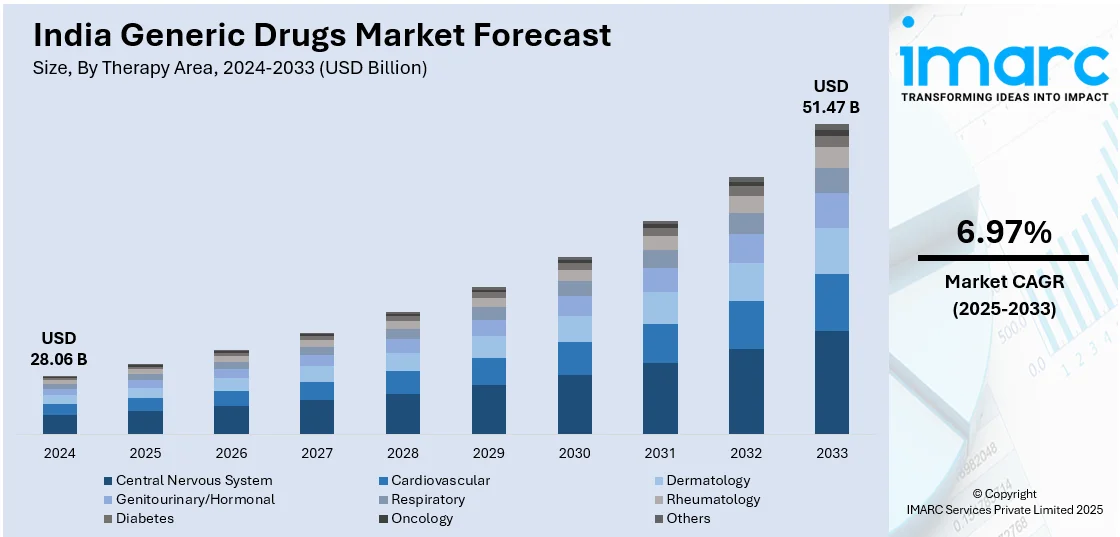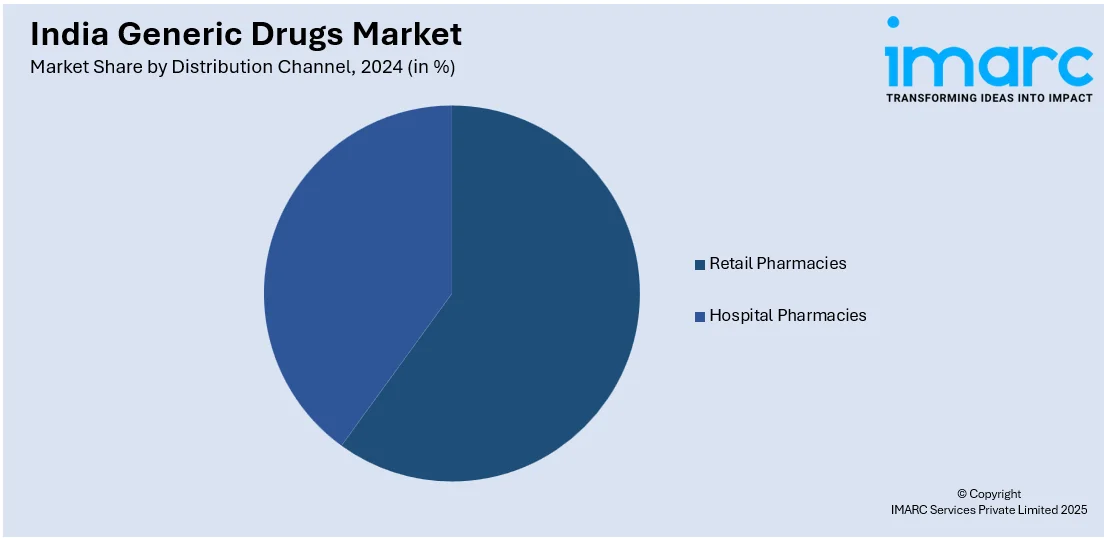
India Generic Drugs Market Size, Share, Trends and Forecast by Therapy Area, Drug Delivery, Distribution Channel, and Region, 2025-2033
India Generic Drugs Market Overview:
The India generic drugs market size reached USD 28.06 Billion in 2024. Looking forward, IMARC Group expects the market to reach USD 51.47 Billion by 2033, exhibiting a growth rate (CAGR) of 6.97% during 2025-2033. The India generic drugs market is driven by a strong pharmaceutical manufacturing base, government initiatives like the PLI scheme to boost domestic API production, rising healthcare demand, cost-effective drug production, growing exports, and an increasing prevalence of chronic diseases, making affordable medications essential for both domestic and international markets.
|
Report Attribute
|
Key Statistics
|
|---|---|
|
Base Year
|
2024 |
|
Forecast Years
|
2025-2033
|
|
Historical Years
|
2019-2024
|
| Market Size in 2024 | USD 28.06 Billion |
| Market Forecast in 2033 | USD 51.47 Billion |
| Market Growth Rate 2025-2033 | 6.97% |
India Generic Drugs Market Trends:
Robust Pharmaceutical Manufacturing Infrastructure
India's pharma sector has a well-developed and large manufacturing base, making it a central force in the international generic medicines market. The nation has a wide network of over 10,000 drug manufacturing facilities and over 3,000 pharmaceutical firms. The well-established industrial base facilitates mass production of generic drugs, providing a stable and affordable supply to domestic and foreign markets. One of the high points of such infrastructure is having many plants based on international standards of regulation. India boasts of having the second-largest number of U.S. FDA-approved manufacturing plants outside of the United States, which points to its concern for keeping rigorous quality checks in place and holding up to world standards. It not only opens up the availability of generic medicines for export purposes but also contributes to the growing credibility of Indian pharmaceuticals internationally. Access to a talented human resource pool still enhances India's manufacturing capacity further. The nation graduates many science and engineering professionals every year, which gives a consistent supply of talent to the pharmaceutical industry. This talent plays a key role in ensuring the efficient functioning of production units, research and development efforts, and regular process improvement for production. Another factor for the success of generic drugs was that the cost of production was low in India. This aspect, coupled with economies of scale, makes the Indian producers develop high-quality drugs at a minimal price. Their affordability has thus been a prominent reason for the widespread usage of generic drugs, primarily in developing nations where healthcare expenditures are minimal.

Supportive Government Policies and Initiatives
The active policies and efforts of the Indian government have been instrumental in developing the generic drugs market. Seeing the potential of the pharmaceutical industry, the government has put in place steps to encourage local production, research and development, and export of generic drugs. One such initiative is the 'Pharma Vision 2020,' whose purpose is to position India as a world leader in end-to-end drug manufacturing. This vision includes several strategies, ranging from infrastructure development, regulatory reforms, and financial incentives, to support the development of the pharmaceutical sector. The government's dedication to this vision has provided a favorable environment for the growth of pharmaceutical companies. The formation of the Pharmaceuticals Export Promotion Council (Pharmexcil) has been a crucial step in aiding generic drug export. Pharmexcil offers support in the form of guidance, funds, and market information to Indian pharmaceutical companies so that they can successfully access global markets. This has resulted in the escalating exports of Indian pharmaceuticals with generic drugs constituting a high percentage of such exports. The government has also concentrated on enhancing healthcare accessibility through schemes such as the Pradhan Mantri Bhartiya Janaushadhi Pariyojana (PMBJP). The program has provided quality generic drugs at lower costs to ordinary citizens through a network of dedicated retail shops named Janaushadhi Kendras. Over 7,500 Janaushadhi Kendras were functional in the nation as of March 2021, increasing the access and acceptability of generic drugs among citizens. Apart from this, the reform of Goods and Services Tax (GST) has streamlined the taxation system and reduced the tax burden on pharmaceutical goods. The supply chain has become easier and reduced the cost of generic drugs both for the consumer and manufacturer following the reform.
India Generic Drugs Market Segmentation:
IMARC Group provides an analysis of the key trends in each segment of the market, along with forecasts at the region/country level for 2025-2033. Our report has categorized the market based on therapy area, drug delivery, and distribution channel.
Therapy Area Insights:
- Central Nervous System
- Cardiovascular
- Dermatology
- Genitourinary/Hormonal
- Respiratory
- Rheumatology
- Diabetes
- Oncology
- Others
The report has provided a detailed breakup and analysis of the market based on the therapy area. This includes central nervous system, cardiovascular, dermatology, genitourinary/hormonal, respiratory, rheumatology, diabetes, oncology, and others.
Drug Delivery Insights:
- Oral
- Injectables
- Dermal/Topical
- Inhalers
A detailed breakup and analysis of the market based on the drug delivery have also been provided in the report. This includes oral, injectables, dermal/topical, and inhalers.
Distribution Channel Insights:

- Retail Pharmacies
- Hospital Pharmacies
A detailed breakup and analysis of the market based on the distribution channel have also been provided in the report. This includes retail pharmacies and hospital pharmacies.
Regional Insights:
- North India
- South India
- East India
- West India
The report has also provided a comprehensive analysis of all the major regional markets, which include North India, South India, East India, and West India.
Competitive Landscape:
The market research report has also provided a comprehensive analysis of the competitive landscape. Competitive analysis such as market structure, key player positioning, top winning strategies, competitive dashboard, and company evaluation quadrant has been covered in the report. Also, detailed profiles of all major companies have been provided.
India Generic Drugs Market News:
- November 2024: Aurobindo Pharma's US-based subsidiary entered into an agreement with a multinational pharma company for developing and selling respiratory products through a cost-sharing arrangement of USD 90 Million. The agreement comprises an upfront payment of USD 25 Million and has the objective of increasing its presence globally. The partnership enhances the Indian market of generic drugs through rising international alliances, improved capabilities in drug development, and greater exports.
- March 2024: The Indian government announced 27 Greenfield Bulk Drug Park projects and 13 new medical device manufacturing facilities under the PLI scheme to increase local production. It is an attempt to cut the dependence on foreign APIs and promote the country's pharmaceutical industry. By providing a stable supply of raw materials, it facilitates India's generic drugs market growth through growing affordability and global competitiveness.
India Generic Drugs Market Report Coverage:
| Report Features | Details |
|---|---|
| Base Year of the Analysis | 2024 |
| Historical Period | 2019-2024 |
| Forecast Period | 2025-2033 |
| Units | Billion USD |
| Scope of the Report | Exploration of Historical Trends and Market Outlook, Industry Catalysts and Challenges, Segment-Wise Historical and Future Market Assessment:
|
| Therapy Areas Covered | Central Nervous System, Cardiovascular, Dermatology, Genitourinary/Hormonal, Respiratory, Rheumatology, Diabetes, Oncology, Others |
| Drug Deliveries Covered | Oral, Injectables, Dermal/Topical, Inhalers |
| Distribution Channels Covered | Retail Pharmacies, Hospital Pharmacies |
| Regions Covered | North India, South India, East India, West India |
| Customization Scope | 10% Free Customization |
| Post-Sale Analyst Support | 10-12 Weeks |
| Delivery Format | PDF and Excel through Email (We can also provide the editable version of the report in PPT/Word format on special request) |
Key Questions Answered in This Report:
- How has the India generic drugs market performed so far and how will it perform in the coming years?
- What is the breakup of the India generic drugs market on the basis of therapy area?
- What is the breakup of the India generic drugs market on the basis of drug delivery?
- What is the breakup of the India generic drugs market on the basis of distribution channel?
- What are the various stages in the value chain of the India generic drugs market?
- What are the key driving factors and challenges in the India generic drugs market?
- What is the structure of the India generic drugs market and who are the key players?
- What is the degree of competition in the India generic drugs market?
Key Benefits for Stakeholders:
- IMARC’s industry report offers a comprehensive quantitative analysis of various market segments, historical and current market trends, market forecasts, and dynamics of the India generic drugs market from 2019-2033.
- The research report provides the latest information on the market drivers, challenges, and opportunities in the India generic drugs market.
- Porter's five forces analysis assist stakeholders in assessing the impact of new entrants, competitive rivalry, supplier power, buyer power, and the threat of substitution. It helps stakeholders to analyze the level of competition within the India generic drugs industry and its attractiveness.
- Competitive landscape allows stakeholders to understand their competitive environment and provides an insight into the current positions of key players in the market.
Need more help?
- Speak to our experienced analysts for insights on the current market scenarios.
- Include additional segments and countries to customize the report as per your requirement.
- Gain an unparalleled competitive advantage in your domain by understanding how to utilize the report and positively impacting your operations and revenue.
- For further assistance, please connect with our analysts.
 Inquire Before Buying
Inquire Before Buying
 Speak to an Analyst
Speak to an Analyst
 Request Brochure
Request Brochure
 Request Customization
Request Customization




.webp)




.webp)












